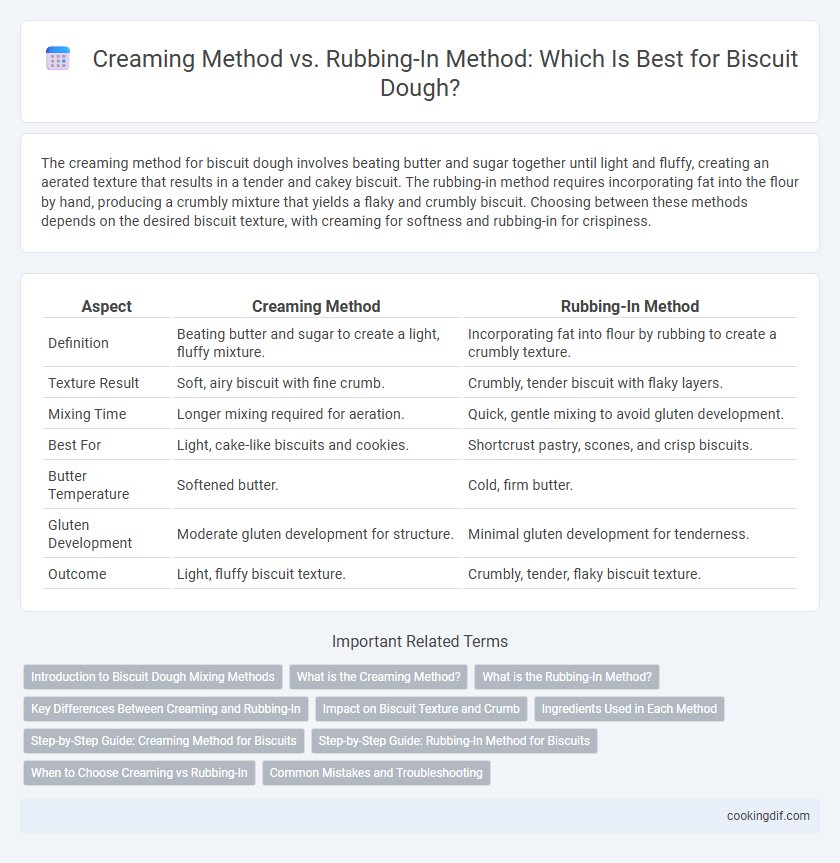The creaming method for biscuit dough involves beating butter and sugar together until light and fluffy, creating an aerated texture that results in a tender and cakey biscuit. The rubbing-in method requires incorporating fat into the flour by hand, producing a crumbly mixture that yields a flaky and crumbly biscuit. Choosing between these methods depends on the desired biscuit texture, with creaming for softness and rubbing-in for crispiness.
Table of Comparison
| Aspect | Creaming Method | Rubbing-In Method |
|---|---|---|
| Definition | Beating butter and sugar to create a light, fluffy mixture. | Incorporating fat into flour by rubbing to create a crumbly texture. |
| Texture Result | Soft, airy biscuit with fine crumb. | Crumbly, tender biscuit with flaky layers. |
| Mixing Time | Longer mixing required for aeration. | Quick, gentle mixing to avoid gluten development. |
| Best For | Light, cake-like biscuits and cookies. | Shortcrust pastry, scones, and crisp biscuits. |
| Butter Temperature | Softened butter. | Cold, firm butter. |
| Gluten Development | Moderate gluten development for structure. | Minimal gluten development for tenderness. |
| Outcome | Light, fluffy biscuit texture. | Crumbly, tender, flaky biscuit texture. |
Introduction to Biscuit Dough Mixing Methods
Creaming method for biscuit dough involves beating fat and sugar together to incorporate air, resulting in a lighter, fluffier texture ideal for soft, cake-like biscuits. Rubbing-in method requires cutting fat into flour until the mixture resembles breadcrumbs, producing a crumbly, tender biscuit with a flaky mouthfeel. Understanding these dough mixing methods is essential for achieving the desired biscuit texture and crumb structure.
What is the Creaming Method?
The creaming method involves beating butter and sugar together until light and fluffy, creating an aerated mixture that helps produce a tender and airy biscuit texture. This technique incorporates air into the dough, resulting in biscuits with a finer crumb and a softer bite. It is ideal for recipes requiring a delicate rise and a buttery flavor.
What is the Rubbing-In Method?
The rubbing-in method is a baking technique where fat, typically butter, is combined with flour by gently rubbing it between the fingertips until the mixture resembles coarse breadcrumbs. This method helps create a tender, crumbly texture in biscuit dough by evenly distributing the fat without overworking the gluten. It is commonly used for shortcrust and scone-style biscuits, resulting in a light and flaky final product.
Key Differences Between Creaming and Rubbing-In
The creaming method incorporates softened butter and sugar, whipping them together to create a light, aerated mixture that results in biscuits with a tender crumb and fluffy texture. In contrast, the rubbing-in method involves cutting cold butter into flour until the mixture resembles coarse breadcrumbs, promoting a crumbly and flaky biscuit structure by minimizing gluten development. These key differences in fat incorporation and mixing technique significantly affect the dough's texture and final biscuit quality.
Impact on Biscuit Texture and Crumb
The creaming method incorporates air into the dough through the beating of fat and sugar, resulting in biscuits with a lighter, fluffier texture and a finer crumb structure. In contrast, the rubbing-in method involves cutting fat into flour until it resembles coarse crumbs, producing a denser, crumblier biscuit with a more tender mouthfeel. The choice between these methods directly influences the biscuit's crumb tenderness and overall texture, with creaming yielding softer biscuits and rubbing-in creating crispier, more layered outcomes.
Ingredients Used in Each Method
The creaming method for biscuit dough typically uses softened butter and sugar beaten together to incorporate air, creating a lighter texture; ingredients often include all-purpose flour, baking powder, milk, and eggs. In contrast, the rubbing-in method involves combining cold fat, such as butter or shortening, with flour by hand until the mixture resembles breadcrumbs, with fewer or no liquid ingredients added initially. This method relies on minimal mixing to prevent gluten development, often incorporating baking powder and sometimes sugar, resulting in a denser biscuit crumb.
Step-by-Step Guide: Creaming Method for Biscuits
The creaming method for biscuit dough involves beating butter and sugar together until light and fluffy, incorporating air to create a tender texture. Gradually add dry ingredients and liquid to maintain the fluffy structure, ensuring even mixing without overworking the dough. This step-by-step approach produces biscuits with a soft crumb and a golden, slightly crisp exterior.
Step-by-Step Guide: Rubbing-In Method for Biscuits
The rubbing-in method for biscuit dough involves incorporating cold butter into flour until the mixture resembles coarse breadcrumbs, ensuring a tender and flaky texture. Begin by measuring and sifting the flour, then cut cold butter into small cubes and rub it quickly into the flour using your fingertips to avoid warming the butter. Add liquid ingredients gradually to bring the dough together gently without overmixing, which helps maintain the biscuits' lightness and crumbly structure.
When to Choose Creaming vs Rubbing-In
Choose the creaming method for biscuit dough when a light, airy texture with well-incorporated air bubbles is desired, as it uses butter and sugar beaten together to create a smooth, fluffy base. Opt for the rubbing-in method when a tender, crumbly biscuit is preferred, achieved by gently combining cold fat with flour to create a sandy, coarse mixture that limits gluten development. Selecting the right method depends on the desired biscuit texture, with creaming suited for soft, cake-like biscuits and rubbing-in ideal for crisp, flaky varieties.
Common Mistakes and Troubleshooting
Overworking biscuit dough using the creaming method can result in tough, dense biscuits, while insufficient mixing in the rubbing-in method often leads to uneven texture and poor rise. Avoid using warm butter in the rubbing-in technique, as it causes the fat to integrate too much, preventing the desired crumbly texture. Ensuring cold ingredients and minimal handling prevents gluten overdevelopment and promotes light, flaky biscuits.
Creaming method vs rubbing-in method for biscuit dough Infographic

 cookingdif.com
cookingdif.com